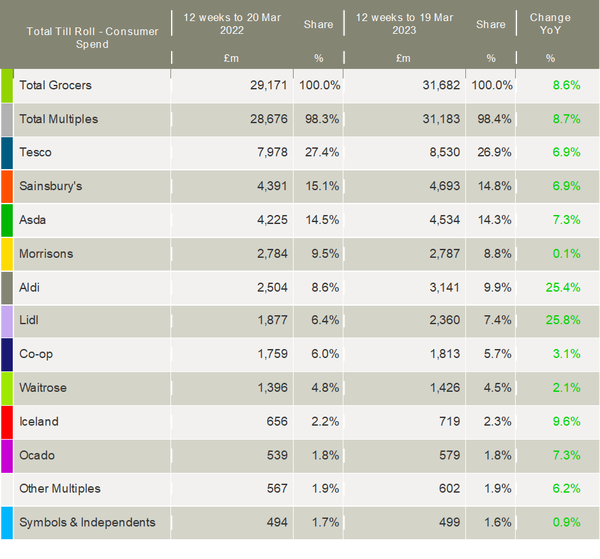Kantar’s latest market data confirms that grocery price inflation is continuing to rise, hitting a record 17.5% over the four weeks to 19 March. Take-home grocery sales grew by 8.6% over the last 12 weeks, suggesting the market is experiencing further volume declines.
After nine months of double-digit grocery price inflation, shoppers are still taking action and hunting around for the best value. Fraser McKevitt, head of retail and consumer insight at Kantar, commented: “Footfall was up in every single grocer this month, with households going to the shops just over four times per week in March. Apart from Christmas, that’s the highest frequency we’ve seen since the start of the pandemic.
“The supermarkets are also tackling grocery price inflation, battling it out to demonstrate value and get customers through their doors. This is a fiercely competitive sector and if people don’t like the prices in one store, they will go elsewhere, with consumers visiting three or more of the top 10 retailers in any given month on average.”
Kantar noted that the majority of retailers are using loyalty card schemes as a tactic to attract and retain shoppers. McKevitt said: “Store cards have emerged as an important way to provide value amid the high cost of living with the grocers offering cheaper prices, coupons and points for people who scan them at the till. Our latest data shows that more than nine in 10 of us have at least one loyalty card in our wallets and usage is on the rise.”
Shoppers also continue seeking savings by buying more own-label lines, with sales up by 15.8% during the last four weeks. However, people appear to be keeping some space in their baskets for brands. Outside Aldi and Lidl, branded goods still make up 52% of the market, and sales grew by 7.2% over the past month, the fastest rate since February 2021. Kantar highlighted that many brands are innovating and launching new products to maintain their popularity, with 10% of their sales in the last year coming from new or updated items.
Across the retailers, Lidl was the fastest-growing supermarket, with its sales climbing 25.8% and market share hitting 7.4%. Aldi secured a new record market share this month at 9.9%, driven by a 25.4% increase in sales.
After several rounds of price cuts, Morrisons returned to growth, with sales rising by 0.1%, giving it an 8.8% market share. Moves by Waitrose to improve its competitiveness also appear to be paying off, with its sales up by 2.1% – the fastest rate of growth for the upmarket supermarket since September 2021.
Asda’s sales increased by 7.3%, just ahead of both Tesco and Sainsbury’s on 6.9%.
Frozen specialist Iceland performed strongly, increasing its market share to 2.3%, up 0.1 percentage point as sales rose by 9.6%.

NAM Implications:
- The standout is the combined share of 17.3% for Aldi and Lidl…
- …a situation unlikely to be reversed!
- Also, Aldi and Lidl each growing at 25% vs rivals at 7% or less, is serious.
- Whilst inflation shows no sign of abatement…
- …resulting bottom line impact means pressure on mults to accelerate Retail Media development.



